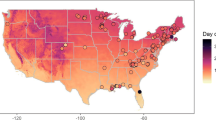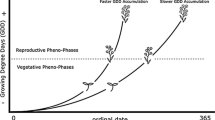Abstract
Disparate ecological datasets are often organized into databases post hoc and then analyzed and interpreted in ways that may diverge from the purposes of the original data collections. Few studies, however, have attempted to quantify how biases inherent in these data (for example, species richness, replication, climate) affect their suitability for addressing broad scientific questions, especially in under-represented systems (for example, deserts, tropical forests) and wild communities. Here, we quantitatively compare the sensitivity of species first flowering and leafing dates to spring warmth in two phenological databases from the Northern Hemisphere. One—PEP725—has high replication within and across sites, but has low species diversity and spans a limited climate gradient. The other—NECTAR—includes many more species and a wider range of climates, but has fewer sites and low replication of species across sites. PEP725, despite low species diversity and relatively low seasonality, accurately captures the magnitude and seasonality of warming responses at climatically similar NECTAR sites, with most species showing earlier phenological events in response to warming. In NECTAR, the prevalence of temperature responders significantly declines with increasing mean annual temperature, a pattern that cannot be detected across the limited climate gradient spanned by the PEP725 flowering and leafing data. Our results showcase broad areas of agreement between the two databases, despite significant differences in species richness and geographic coverage, while also noting areas where including data across broader climate gradients may provide added value. Such comparisons help to identify gaps in our observations and knowledge base that can be addressed by ongoing monitoring and research efforts. Resolving these issues will be critical for improving predictions in understudied and under-sampled systems outside of the temperature seasonal mid-latitudes.





Similar content being viewed by others
References
Abu-Asab MS, Peterson PM, Shetler SG, Orli SS. 2001. Earlier plant flowering in spring as a response to global warming in the Washington, DC, area. Biodivers Conserv 10:597–612.
Augspurger CK. 2009. Spring 2007 warmth and frost: phenology, damage, and refoliation in a temperate deciduous forest. Funct Ecol 23:1031–9.
Cook BI, Cook ER, Huth PC, Thompson JE, Forster A, Smiley D. 2008. A cross-taxa phenological dataset from Mohonk Lake, NY and its relationship to climate. Int J Climatol 28:1369–83.
Dunnell KL, Travers SE. 2011. Shifts in the flowering phenology of the Northern Great Plains: patterns over 100 years. Am J Bot 98:935–45.
Fitter AH, Fitter RSR. 2002. Rapid changes in flowering time in British plants. Science 296:1689.
Haylock MR, Hofstra N, Tank AMGK, Klok EJ, Jones PD, New M. 2008. A European daily high-resolution gridded data set of surface temperature and precipitation for 1950–2006. J Geophys Res 113:D20119.
Hofstra N, Haylock M, New M, Jones PD. 2009. Testing E-OBS European high-resolution gridded data set of daily precipitation and surface temperature. J Geophys Res 114:D21101.
Inouye DW. 2008. Effects of climate change on phenology, frost damage, and floral abundance of montane wildflowers. Ecology 89:353–62.
Jackson ST, Betancourt JL, Booth RK, Gray ST. 2009. Ecology and the ratchet of events: climate variability, niche dimensions, and species distributions. Proc Natl Acad Sci 106:19685–92.
Klok EJ, Klein Tank AMG. 2009. Updated and extended European dataset of daily climate observations. Int J Climatol 29:1182–91.
Koch E, Adler S, Lipa M, Ungersbock M, Zach-Hermann S (2010a) The Pan European phenological database PEP725. Berichte des Meteorologischen Institutes der Albrecht-Ludwigs-Universität Freiburg. In Proceedings of the 7th conference on Biometeorology.
Koch E, Adler S, Ungersbock M, Zach-Hermann S (2010b) PEP725 Pan European Phenological Database. Geophys Res Abst 12.
Leon AJ, Lee M, Andrade FH. 2001. Quantitative trait loci for growing degree days to flowering and photoperiod response in sunflower (Helianthus annuus L.). Theor Appl Genet 102:497–503.
Loiselle BA, Jørgensen PM, Consiglio T, Jiménez I, Blake JG, Lohmann LG, Montiel OM. 2008. Predicting species distributions from herbarium collections: does climate bias in collection sampling influence model outcomes? J Biogeogr 35:105–16.
McMaster GS, Wilhelm WW. 1997. Growing degree-days: one equation, two interpretations. Agric For Meteorol 87:291–300.
Menzel A. 2000. Trends in phenological phases in Europe between 1951 and 1996. Int J Biometeorol 44:76–81.
Menzel A, Fabian P. 1999. Growing season extended in Europe. Nature 397:659.
Menzel A, Sparks TH, Estrella N et al. 2006. European phenological response to climate change matches the warming pattern. Glob Change Biol 12:1969–76.
Moeller DA. 2004. Facilitative interactions among plants via shared pollinators. Ecology 85:3289–301.
Olsson K, Ågren J. 2002. Latitudinal population differentiation in phenology, life history and flower morphology in the perennial herb Lythrum salicaria. J Evol Biol 15:983–96.
Palmer TM, Stanton ML, Young TP. 2003. Competition and coexistence: exploring mechanisms that restrict and maintain diversity within mutualist guilds. Am Nat 162:S63–79.
Parmesan C, Yohe G. 2003. A globally coherent fingerprint of climate change impacts across natural systems. Nature 421:37–42.
Parry ML. 2007. Climate Change 2007: Impacts, adaptation and vulnerability: Contribution of Working Group II to the Fourth Assessment Report of the Intergovernmental Panel on Climate Change. Cambridge: Cambridge University Press.
PEP725 (2010) Pep725: Pan European Phenology Data. http://www.zamg.ac.at/pep725/.
Peterson TC, Vose RS. 1997. An overview of the Global Historical Climatology Network temperature database. Bull Am Meteorol Soc 78:2837–49.
Richardson AD, Bailey AS, Denny EG, Martin CW, O’Keefe J. 2006. Phenology of a northern hard-wood forest canopy. Glob Change Biol 12:1174–88.
Root TL, Price JT, Hall KR, Schneider SH, Rosenzweig C, Pounds JA. 2003. Fingerprints of global warming on wild animals and plants. Nature 421:57–60.
Rosenzweig C, Karoly D, Vicarelli M et al. 2008. Attributing physical and biological impacts to anthropogenic climate change. Nature 453:353–7.
Rötzer T, Chmielewski FM. 2001. Phenological maps of Europe. Clim Res 18:249–57.
Scheifinger H, Menzel A, Koch E, Peter C, Ahas R. 2002. Atmospheric mechanisms governing the spatial and temporal variability of phenological phases in central Europe. Int J Climatol 22:1739–55.
Scheifinger H, Menzel A, Koch E, Peter C. 2003. Trends of spring time frost events and phenological dates in Central Europe. Theor Appl Climatol 74:41–51.
Schwartz MD, Hanes JM. 2010. Intercomparing multiple measures of the onset of spring in eastern North America. Int J Climatol 30:1614–26.
Schwartz MD, Reiter BE. 2000. Changes in North American spring. Int J Climatol 20:929–32.
Schwartz MD, Ahas R, Aasa A. 2006. Onset of spring starting earlier across the Northern Hemisphere. Glob Change Biol 12:343–51.
Sherry RA, Zhou X, Gu S et al. 2007. Divergence of reproductive phenology under climate warming. Proc Natl Acad Sci 104:198.
Smith JW. 1915. Phenological dates and meteorological data recorded by Thomas Mikesell at Wauseon, Fulton County, Ohio. Mon Weather Rev Suppl 2:21–93.
Sparks TH, Górska-Zajaczkowska M, Wojtowicz W, Tryjanowski P. (2010) Phenological changes and reduced seasonal synchrony in western Poland. Int J Biometeorol 55:1–7.
Stinchcombe JR, Weinig C, Ungerer M et al. 2004. A latitudinal cline in flowering time in Arabidopsis thaliana modulated by the flowering time gene FRIGIDA. Proc Natl Acad Sci 101:4712.
Travers SE, Dunnell K. 2009. First-flowering dates of plants in the Northern Great Plains. Ecology 90:2332.
Trivedi MR, Berry PM, Morecroft MD, Dawson TP. 2008. Spatial scale affects bioclimate model projections of climate change impacts on mountain plants. Glob Change Biol 14:1089–103.
Walther GR. 2009. Two steps forward, one step back. Funct Ecol 23:1029–30.
Walther GR, Post E, Convey P et al. 2002. Ecological responses to recent climate change. Nature 416:389–95.
Wetherill K (2000) Plant phenology transects. Tech. rep., Sevilleta Long Term Ecological Research Site.
Willis CG, Ruhfel B, Primack RB, Miller-Rushing AJ, Davis CC. 2008. Phylogenetic patterns of species loss in Thoreaus woods are driven by climate change. Proc Natl Acad Sci 105:17029.
Wright V (2001) Prairies phenology. Tech. rep., Konza Environmental Education Program.
Zimmerman JK, Wright SJ, Calderon O, Pagan MA, Paton S. 2007. Flowering and fruiting phenologies of seasonal and aseasonal neotropical forests: the role of annual changes in irradiance. J Trop Ecol 23:231–51.
Acknowledgments
Primary data collections were made possible through the support of many granting agencies; please see ESM for complete information and grant numbers. This work was conducted as a part of the “Forecasting Phenology” Working Group supported by the National Center for Ecological Analysis and Synthesis, a center funded by the National Science Foundation (NSF) (Grant #EF- 0553768), the University of California, Santa Barbara, and the State of California. Special thanks to the many data holders and data managers who assisted us throughout the process including K. Vanderbilt and K. Wetherill (SEV), Chris Nytch and Jess Zimmerman (LUQ), George Aldridge and David Inouye (GTH), John O’Keefe (HVD), and Paul Huth, Shanan Smiley, and John Thompson from the Mohonk Preserve (MHK). Some data used in this publication were obtained by scientists of the Hubbard Brook Ecosystem Study; this publication has not been reviewed by those scientists. The Hubbard Brook Experimental Forest is operated and maintained by the Northeastern Research Station, U.S. Department of Agriculture, Newtown Square, Pennsylvania. Additional support was also provided by the USA National Phenology Research Coordination Network, supported by NSF grant #IOS-0639794. NJBK was supported by the NSERC CREATE Training Program in Biodiversity Research. PEP725 data were provided by the members of the PEP725 project. Special thanks to E. Koch and W. Lipa for providing the PEP725 data and the accompanying climate data. Support for EMW came from the NSF Postdoctoral Fellow program (Grant #DBI-0905806). Thanks to the editors, two anonymous reviewers, Jonathan Hanes, and David Inouye for providing valuable comments that significantly improved the quality of this manuscript. LDEO contribution number #7580.
Author information
Authors and Affiliations
Corresponding author
Additional information
Author Contributions
All authors contributed to the study design and offered comments on this manuscript as part of the “Forecasting Phenology” working group funded by the National Center for Ecological Analysis and Synthesis. Author Cook conceived of and designed the study, analyzed the data, and wrote the paper. Wolkovich and Davies contributed significantly to the refinement of the ideas and analyses and assisted with the writing. Ault contributed significantly to the analyses, including processing of the GHCN climate data. Betancourt contributed significantly to the writing and study design. The first five authors are listed in order of their contributions; all other authors are listed alphabetically.
Electronic supplementary material
Below is the link to the electronic supplementary material.
Rights and permissions
About this article
Cite this article
Cook, B.I., Wolkovich, E.M., Davies, T.J. et al. Sensitivity of Spring Phenology to Warming Across Temporal and Spatial Climate Gradients in Two Independent Databases. Ecosystems 15, 1283–1294 (2012). https://doi.org/10.1007/s10021-012-9584-5
Received:
Accepted:
Published:
Issue Date:
DOI: https://doi.org/10.1007/s10021-012-9584-5




